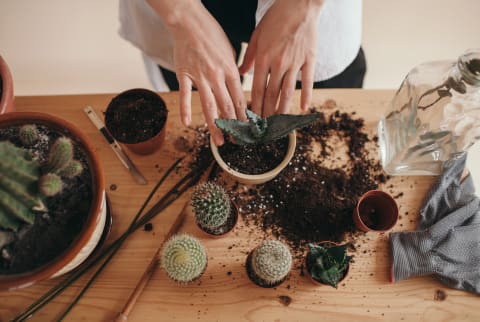Advertisement
The Common Kitchen Item That's Great For Aerating Houseplant Soil


When it comes to houseplant maintenance tools, we all know about the basics: Some fertilizer, a watering can, maybe some shears for propagating clippings. However, there is one instrument that's lesser-known but essential for helping houseplants live up to their greatest green potential—and it's probably already in your kitchen, wedged in the back of your utensil drawer.
Any guesses? It's the almighty chopstick. Reusable ones and the wooden stashaways from takeout orders are equally good at aerating your plants' soil.
How to aerate soil using chopsticks.
Thirsty houseplants love guzzling up water, but all that moisture can eventually take a toll on their surrounding soil. Observant plant parents have likely noticed that potted soil becomes denser and harder to the touch over time. It may even absorb less moisture, leaving little puddles of water on its surface. This is the result of a natural process called soil compaction, in which soil compresses after repeated watering. Compressed soil is full of roadblocks that keep water and nutrients from reaching roots, so it can eventually delay plant growth.
Chopsticks are the perfect size and shape to break up and introduce more air to compacted soil, essentially acting as worms and other insects would in nature.
That's why Darryl Cheng, plant pro and author of New Plant Parent, likes to carry a chopstick around on his usual watering rounds. "One way to check for dryness is to just probe around the soil with a chopstick. While I'm probing, I'm also feeling how compacted the soil is," he tells mbg.
While heartier plants like succulents can thrive in harder soils, most leafy varieties (philodendrons, monsteras, pothos, etc.) prefer a lighter, looser home. So if Cheng feels that their soil is getting compacted, he'll give it a few gentle proddings with the chopstick before watering.
Once the chopstick reaches the bottom of the pot, he'll twirl it around slightly to introduce more air pockets into the soil. There's no need to go overboard, and two or three proddings total around the soil perimeter should be enough for medium-size plants.
The location of your indents doesn't matter as much, but if you feel any sort of significant resistance, you'll want to move over slightly to avoid harming the root system. That being said, roots are pretty resilient, so, as long as you're not using the chopstick with reckless abandon, they should be totally fine post-poke.
"Plant roots are actually the toughest and most regenerative of the whole part of the plant," Cheng says. "The reality is that of all the parts of the plant, roots grow back the fastest—but I'm definitely not jabbing in there violently." Once your air pockets are in, you can go ahead and water the plant as usual.
This habit should keep your soil in tiptop shape, but you'll still need to swap it out eventually. Once your plant hits a year in the same soil, it's time to repot it in a fresh home.